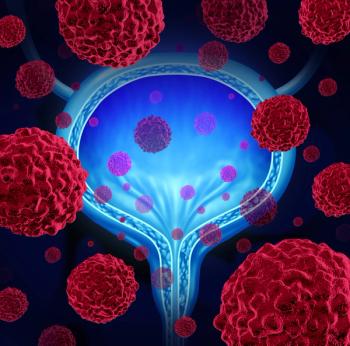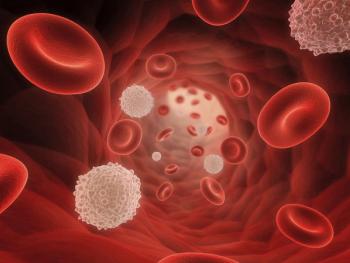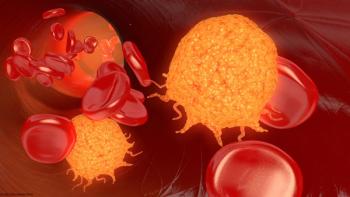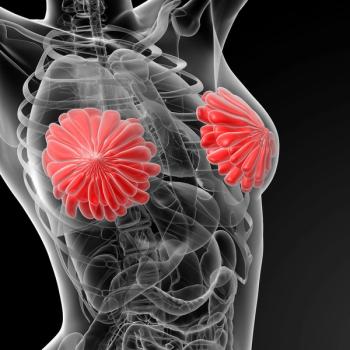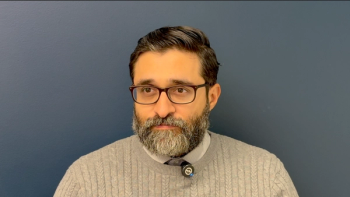
IDH Triplet Therapy Shows Excellent Outcomes in IDH-Mutant AML
Current data support prospective studies comparing IDH triplet vs IDH doublet therapies among patients with IDH-mutant acute myeloid leukemia.
Investigational triplet regimens containing venetoclax (Venclexta) demonstrated clinical efficacy among patients with IDH-mutated acute myeloid leukemia (AML) who are ineligible to receive intensive chemotherapy, according to findings from a pair of phase 1b/2 trials (NCT03471260; NCT04774393) published in the Journal of Clinical Oncology.1
Among all evaluable patients (n = 60), the composite complete remission (CRc) rate was 92% and the objective response rate was 95%. Additionally, data showed a median time to first response and best response of 27 days and 61 days, respectively.
Among those with IDH1-mutated disease (n = 37), the CRc rate was 86% and the minimal residual disease negativity rate was 81%; these respective rates were 100% and 95% among patients with IDH2 mutations (n = 23). The CRc rate was 71% in patients with treated secondary AML (tsAML; n = 17) compared with 98% among those with non-tsAML (n = 43).
Data showed a median overall survival (OS) that was not reached (NR; 95% CI, 31.3-NR) in patients with IDH1 mutations vs 35.2 months (95% CI, 14.2-NR) among those with IDH2 mutations; the 2-year OS rates were 73% and 65%, respectively. Additionally, the median event-free survival (EFS) in each group was NR (95% CI, 36.8-NR) vs 26.5 months (95% CI, 11.0-NR), with respective 2-year EFS rates of 72% and 60%. The 2-year cumulative incidence of relapse (CIR) was 24% (95% CI, 0%-43%) in the IDH1-mutated disease subgroup and 24% (95% CI, 0%-46%) in the IDH2-mutated disease subgroup.
In the non-tsAML and tsAML populations, respectively, the median OS was NR (95% CI, NR-NR) vs 10.9 months (95% CI, 7.8-NR) and the 2-year OS rates were 84% and 34%. Additionally, the median EFS was NR (95% CI, 36.8-NR) and 7.7 months (95% CI, 4.8-NR) in each group, with respective 2-year EFS rates of 79% and 34%. At 2 years, the CIR rate was 20% (95% CI, 0%-36%) vs 38% (95% CI, 0%-65%).
“In summary, these data demonstrate excellent outcomes of IDH triplet therapy in the treatment of newly diagnosed, [intensive chemotherapy]–ineligible IDH-mutant AML. Enrollment in these trials is ongoing…with expansion to additional clinical sites to augment enrollment and confirm generalizability among academic settings,” lead study author Courtney D. DiNardo, MD, MSCE, from the Department of Leukemia at The University of Texas MD Anderson Cancer Center, wrote with coauthors.1 “Prospective studies comparing IDH triplet vs IDH doublet regimens are warranted.”
In one of the investigator-initiated phase 1b/2 trials, patients were assigned to receive venetoclax orally each day on days 1 to 14, oral ivosidenib (Tibsovo) daily on days 15 to 28 of the first cycle followed by days 1 to 28 of each subsequent cycle, and azacitidine (Vidaza) intravenously or subcutaneously on days 1 to 7 of 28-day cycles.2 Treatment persisted until disease progression or unacceptable toxicity. This trial only included patients with IDH1-mutated AML.
In the other trial, patients received oral decitabine/cedazuridine on days 1 to 5, oral venetoclax on days 1 to 14, and oral ivosidenib or oral enasidenib (Idhifa) on days 1 to 28 of 28-day cycles for 12 cycles or until disease progression or unacceptable toxicity.3 Patients with IDH1 mutations received ivosidenib as part of their regimen, whereas those with IDH2 mutations received enasidenib.
The dual primary end points of both trials were the safety and efficacy of the combination regimens. Investigators evaluated efficacy based on CRc within the first 5 cycles of study treatment. Other end points included OS, EFS, CIR, and DOR.
The median patient age was 71 years (range, 62-87), and most patients were White (92%). Of note, most patients had de novo AML (58%), adverse-risk disease per European Leukemia Network (ELN) 2022 criteria (78%), favorable-risk disease per ELN 2024 guidelines (72%), and IDH1 mutations (63%).
The median number of treatment cycles was 5 (range, 1-52), and the most common reasons for treatment discontinuation included stem cell transplant (49%), relapse (23%), patient choice (10%), lack of response (8%), and death (5%). Among patients in remission, 16% and 12% required red cell transfusions and platelet transfusions, respectively.
Any-grade nonhematologic adverse effects (AEs) occurred in 77% of patients, the most common of which included infections (42%), hyperbilirubinemia (27%), diarrhea (20%), and transaminitis (15%). Grade 3 or higher AEs affected 43% of patients and included hyperbilirubinemia (5%), differentiation syndrome (3%), diarrhea (2%), and transaminitis (2%).
References
- DiNardo CD, Marvin-Peek J, Loghavi S, et al. Outcomes of frontline triplet regimens with a hypomethylating agent, venetoclax, and isocitrate dehydrogenase inhibitor for intensive chemotherapy–ineligible patients with isocitrate dehydrogenase–mutated AML. J Clin Oncol. Published online June 13, 2025. doi:10.1200/JCO-25-00640
- Ivosidenib and venetoclax with or without azacitidine in treating patients with IDH1 mutated hematologic malignancies. ClinicalTrials.gov. Updated April 23, 2025. Accessed July 7, 2025. https://tinyurl.com/59ndw64d
- Decitabine/cedazuridine and venetoclax in combination with ivosidenib or enasidenib for the treatment of relapsed or refractory acute myeloid leukemia. ClinicalTrials.gov. Updated June 3, 2025. Accessed July 7, 2025. https://tinyurl.com/42rkyns4
Newsletter
Stay up to date on recent advances in the multidisciplinary approach to cancer.


